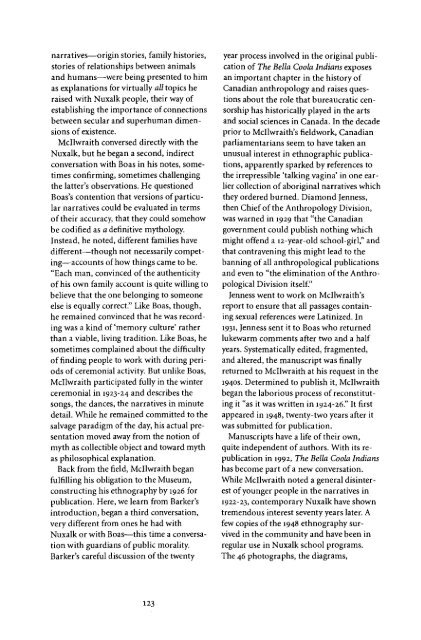To All Appearances A Lady - University of British Columbia
To All Appearances A Lady - University of British Columbia
To All Appearances A Lady - University of British Columbia
Create successful ePaper yourself
Turn your PDF publications into a flip-book with our unique Google optimized e-Paper software.
narratives—origin stories, family histories,<br />
stories <strong>of</strong> relationships between animals<br />
and humans—were being presented to him<br />
as explanations for virtually all topics he<br />
raised with Nuxalk people, their way <strong>of</strong><br />
establishing the importance <strong>of</strong> connections<br />
between secular and superhuman dimensions<br />
<strong>of</strong> existence.<br />
Mcllwraith conversed directly with the<br />
Nuxalk, but he began a second, indirect<br />
conversation with Boas in his notes, sometimes<br />
confirming, sometimes challenging<br />
the latter's observations. He questioned<br />
Boas's contention that versions <strong>of</strong> particular<br />
narratives could be evaluated in terms<br />
<strong>of</strong> their accuracy, that they could somehow<br />
be codified as a definitive mythology.<br />
Instead, he noted, different families have<br />
different—though not necessarily competing—accounts<br />
<strong>of</strong> how things came to be.<br />
"Each man, convinced <strong>of</strong> the authenticity<br />
<strong>of</strong> his own family account is quite willing to<br />
believe that the one belonging to someone<br />
else is equally correct." Like Boas, though,<br />
he remained convinced that he was recording<br />
was a kind <strong>of</strong>'memory culture' rather<br />
than a viable, living tradition. Like Boas, he<br />
sometimes complained about the difficulty<br />
<strong>of</strong> finding people to work with during periods<br />
<strong>of</strong> ceremonial activity. But unlike Boas,<br />
Mcllwraith participated fully in the winter<br />
ceremonial in 1923-24 and describes the<br />
songs, the dances, the narratives in minute<br />
detail. While he remained committed to the<br />
salvage paradigm <strong>of</strong> the day, his actual presentation<br />
moved away from the notion <strong>of</strong><br />
myth as collectible object and toward myth<br />
as philosophical explanation.<br />
Back from the field, Mcllwraith began<br />
fulfilling his obligation to the Museum,<br />
constructing his ethnography by 1926 for<br />
publication. Here, we learn from Barker's<br />
introduction, began a third conversation,<br />
very different from ones he had with<br />
Nuxalk or with Boas—this time a conversation<br />
with guardians <strong>of</strong> public morality.<br />
Barker's careful discussion <strong>of</strong> the twenty<br />
year process involved in the original publication<br />
<strong>of</strong> The Bella Coola Indians exposes<br />
an important chapter in the history <strong>of</strong><br />
Canadian anthropology and raises questions<br />
about the role that bureaucratic censorship<br />
has historically played in the arts<br />
and social sciences in Canada. In the decade<br />
prior to Mcllwraith's fieldwork, Canadian<br />
parliamentarians seem to have taken an<br />
unusual interest in ethnographic publications,<br />
apparently sparked by references to<br />
the irrepressible 'talking vagina' in one earlier<br />
collection <strong>of</strong> aboriginal narratives which<br />
they ordered burned. Diamond Jenness,<br />
then Chief <strong>of</strong> the Anthropology Division,<br />
was warned in 1929 that "the Canadian<br />
government could publish nothing which<br />
might <strong>of</strong>fend a 12-year-old school-girl," and<br />
that contravening this might lead to the<br />
banning <strong>of</strong> all anthropological publications<br />
and even to "the elimination <strong>of</strong> the Anthropological<br />
Division itself."<br />
Jenness went to work on Mcllwraith's<br />
report to ensure that all passages containing<br />
sexual references were Latinized. In<br />
1931, Jenness sent it to Boas who returned<br />
lukewarm comments after two and a half<br />
years. Systematically edited, fragmented,<br />
and altered, the manuscript was finally<br />
returned to Mcllwraith at his request in the<br />
1940s. Determined to publish it, Mcllwraith<br />
began the laborious process <strong>of</strong> reconstituting<br />
it "as it was written in 1924-26." It first<br />
appeared in 1948, twenty-two years after it<br />
was submitted for publication.<br />
Manuscripts have a life <strong>of</strong> their own,<br />
quite independent <strong>of</strong> authors. With its republication<br />
in 1992, The Bella Coola Indians<br />
has become part <strong>of</strong> a new conversation.<br />
While Mcllwraith noted a general disinterest<br />
<strong>of</strong> younger people in the narratives in<br />
1922-23, contemporary Nuxalk have shown<br />
tremendous interest seventy years later. A<br />
few copies <strong>of</strong> the 1948 ethnography survived<br />
in the community and have been in<br />
regular use in Nuxalk school programs.<br />
The 46 photographs, the diagrams,<br />
123

















